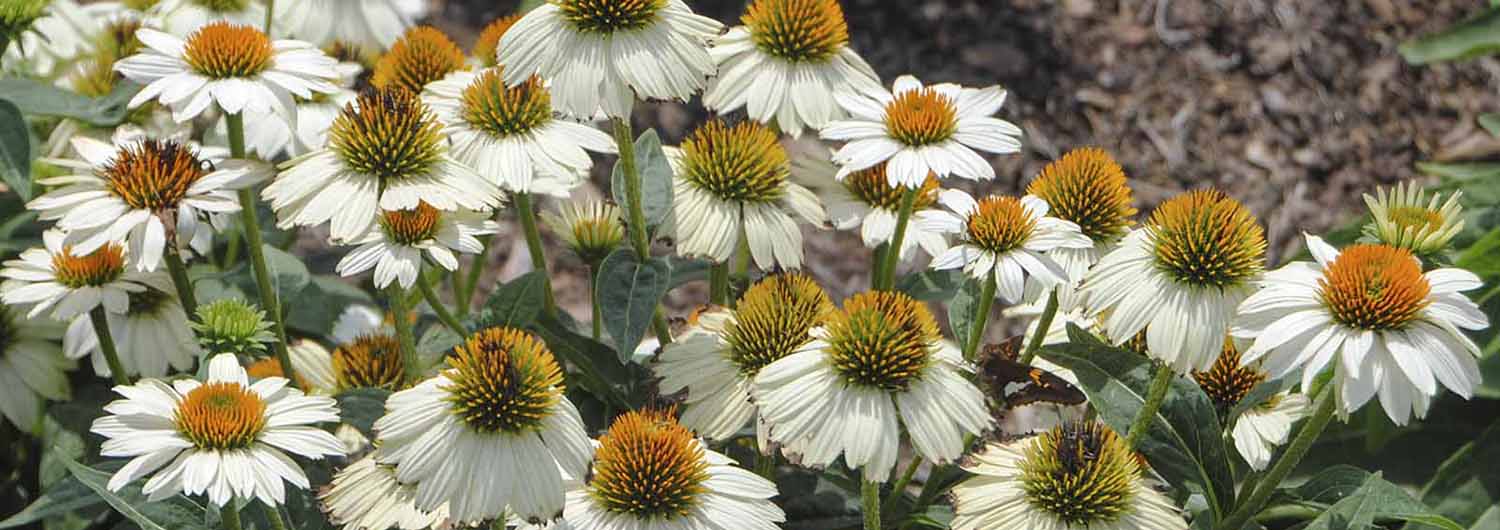Perennials Trial Report
North Carolina State University
Raleigh, North Carolina
2013–2014
JC Raulston Arboretum at
North Carolina State University
Raleigh, North Carolina
Ted Bilderback
Director
Bernadette Clark
Agricultural Research Technician
Department of Horticultural Science
JC Raulston Arboretum
Table of Contents
General Introductory Notes and Acknowledgements
Understanding Our Data
Climate Graphs
Plant Material Sources
Results
General Introductory Notes and Acknowledgements
The Perennials Trial are located adjacent to the Color Trials at NC State University within the JC Raulston Arboretum (JCRA) in Raleigh. The JCRA is a ten and a half acre site administered by the Department of Horticultural Science and located on 35° 47'N latitude, longitude 78° 42' W, with an elevation of 400'.
Plants to be entered into our trials are received in one of three ways—seeds, rooted cuttings/plugs or finished plants/pot. Virtually all are grown within controlled greenhouse environments prior to placement in protected outdoor structures for hardening off. Plant spacing in the trials is based on the estimated mature size of entrant that fits to a 4' × 4' area or by the number of plants sent. Each entry is evaluated for two complete calendar years, being removed after the spring flush in year three. After the plants are established, they are evaluated for hardiness and landscape performance with ratings regularly taken.
Acknowledgements
We thank the vegetative and seed companies that participate in our trials. The services we provide would not be possible without the cooperation and support of these companies. We appreciate this confidence and trust and we look forward to continuing our partnership.
Lastly, we are thankful to other departmental staff and the volunteers of the JC Raulston Arboretum who assisted in transplanting and maintaining the plants … we couldn't have done it without you all!
Participants
2012
Foremostco, Inc.
Sakata Seed America
Skagit Gardens
2013
Ball Ingenuity
Kieft-Pro Seeds
We also thank the following companies for their support of material donations:
- BASF, 26 Davis Drive, Research Triangle Park, NC 27709
- Harrell's, P.O.Box 807, Lakeland, FL 33802
- Sun Gro Horticulture, 3723 Hogshead Road, Apopka, FL 32702
Understanding Our Data
Cultural Data
Trials are conducted in amended beds. Prior to planting, beds are fertilized with 10-10-10 granular fertilizer and tilled. Depending on requirements plants are placed either in the shade structure or fully exposed in the sun. All plant material is mulched with composted leaf mulch to a 2"–3" depth after planting. Pre-emergent herbicides are used at the initial planting and repeated each subsequent spring/summer season. Hand weeding is done at all other times. Later in the season, a post-emergent herbicide application along the edge of the beds was done on an as needed basis. An in-ground irrigation system delivers 1"–1.5" of water to the beds each week. Plant height and width measurements (recorded in inches) are taken twice during the growing season, usually at the end of June and again at the end of July. Data was collected from a representative plant, not the largest or the smallest but an average plant. Dormant plants were cut back in the fall/early winter to clean up the area and reduce overwintering habitat for insects and diseases.
Evaluations
The purpose of our perennials trial is to evaluate the plant material under conditions unique to our location. Our summer growing conditions are typically hot temperatures with high humidity. There is little nighttime temperature relief/recovery; average summer nighttime temperatures can be in the 70s. Irrigation is required all season.
Plants were given a visual rating by the same person. The overall rating was based on plant performance and appearance, including floriferousness, plant size and shape, and freedom from insect and disease problems. The rating scale ranged from 1 (very poor) to 5 (excellent) with 0.5 unit increments possible; a 0 rating indicated that all plants of the cultivar trial died.
What do we look for?
- General Plant Growth – healthy appearance, attractive foliage, uniform growth
- Flowers – floriferousness, bloom duration, uniform color, does it hold up after a heavy rain
- Pests and diseases – any visible evidence of damage: distorted or chewed foliage
- Heat tolerance – do the flowers and plants hold up in the heat, does the flower color fade or stripe
- Hardiness (survival) – determined (in the spring) by the number of plants that made it through or emerged after the winter
Installation Date
Most entries were planted into their permanent trial location on:
- 2012 entries on April 10, 2012, and the rose entries were planted on September 25, 2012
- 2013 entries on May 21, 2013
Entries that did not survive
Died 2012
Dianthus (Bouquet™ Purple)
Heuchera (Kira™ Tropical Forest)
Lavandula angustifolia 'Ellagance Snow' (Ellagance®™ Snow)
Phlox 'Shockwave'
Scabiosa columbaria 'Mariposa Violet'
Died 2013
Armeria pseudarmeria 'Ballerina Lilac' (Ballerina®™ mix)
Digitalis purpurea (Dalmatian Purple Improved)
Digitalis purpurea (Dalmation White Improved)
Primula polyanthus (SuperNova mix)
Heuchera 'Autumn Leaves'
The best way to really evaluate our trials is to come in person. The JCRA is open 365 days a year.
Average Monthly Precipitation and Temperature

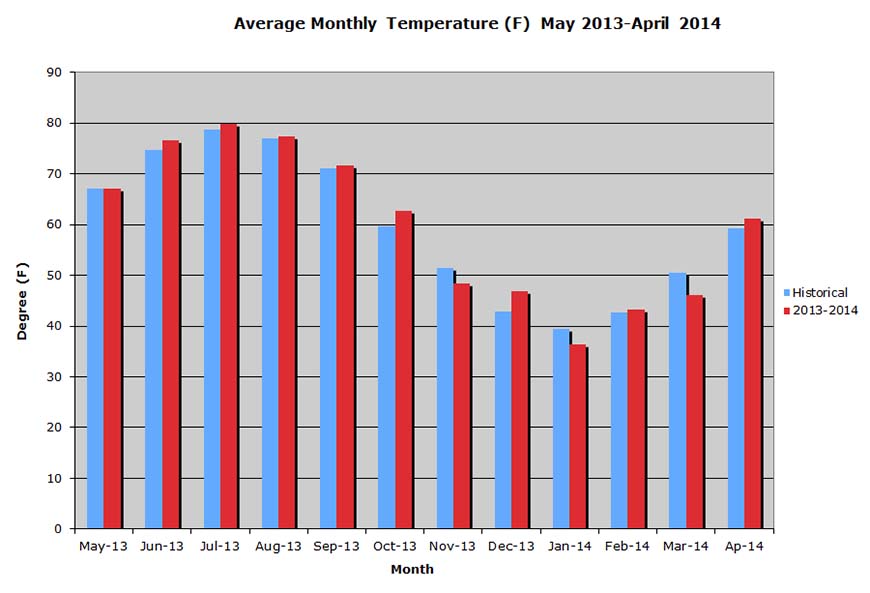
Summer 2013 temperatures were milder than normal, not the usual extremes we endure. We experienced heavier than normal rainfall and cloudier conditions. Rain totals for this six-month period exceeded the norm by 8.2". While some of our plants tolerated the soggy conditions, others struggled. Our first 90°F day was on June 12, very late for our area, and our hottest temperature (95°F) occurred on August 12.
Most of us are glad to leave the winter of 2013–2014 behind. The numbers said it was pretty average, but we all know how crazy it really was. It was a season of wild fluctuations, extreme cold periods followed by warm periods. On January 7, 2014, we experienced our first single digit temperatures since January 2000. We also had periods of the coldest afternoon highs since 1994. According to a weather researcher at Iowa State, from December 1, 2013–March 1, 2014, we spent approximately 20% of the time below freezing. We had more rainfall, especially December and March. Several snow and icing events added to these wet conditions.
Seed and Plant Material Sources
Ball Ingenuity, P.O. Box 335, West Chicago, IL 60185
Foremostco, Inc., 8457 NW 66th Street, Miami, FL 33166
Kieft-Pro-Seeds, P.O. Box 335, West Chicago, IL 60185
Sakata Seed America, 18095 Serene Drive, Morgan Hill, CA 95037
Skagit Gardens, 3100 Old Highway 99 South, Mount Vernon, WA 98273
Please get in touch with these companies if you have specific questions regarding individual species and cultivars.
Trial Results
Perennials Planted in 2012
Rosa
Sunrosa® Red rose
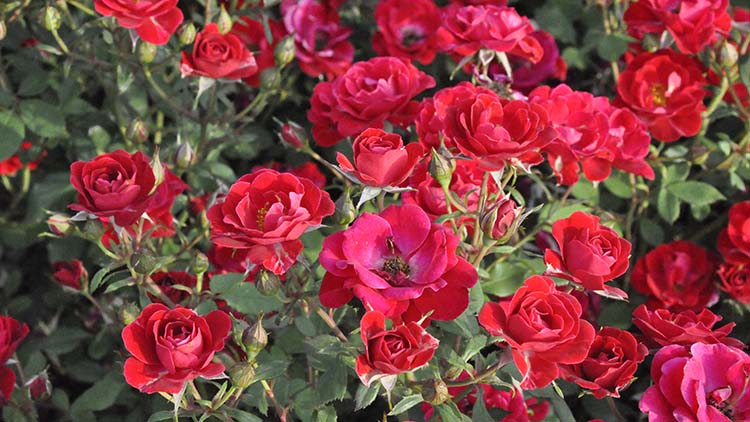
- Company
- Foremostco
- Year Planted
- 2012
- Height
- 23"
- Spread
- 18"
- Number Planted
- 9
- Survival
- 100%
- Comments
-
Continues to be disease resistant; low maintenance; small, reddish colored blossoms cover the plant from May through mid-October; petite plants with attractive red colored new foliage; mild fragrance; Sunrosa series is the shortest of the rose series evaluated.
Rosa
Sunrosa® Yellow rose
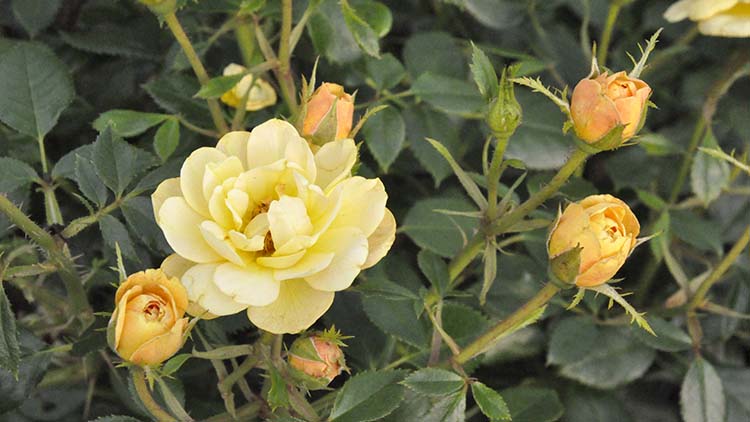
- Company
- Foremostco
- Year Planted
- 2012
- Height
- 22"
- Spread
- 16"
- Number Planted
- 9
- Survival
- 100%
- Comments
-
Disease resistant, but less resistant to leaf spot than others evaluated; low maintenance; petite, yellow blossoms cover the plant from May to mid-October; fragrant blossoms; Sunrosa series is the shortest of the rose series evaluated.
Scabiosa columbaria 'Mariposa Violet'
pincushion flower
- Company
- Skagit Gardens
- Year Planted
- 2012
- Height
- -
- Spread
- -
- Number Planted
- 12
- Survival
- 0%
- Comments
- Died summer 2012.
Campanula 'Ringsabell Rose'
campanula
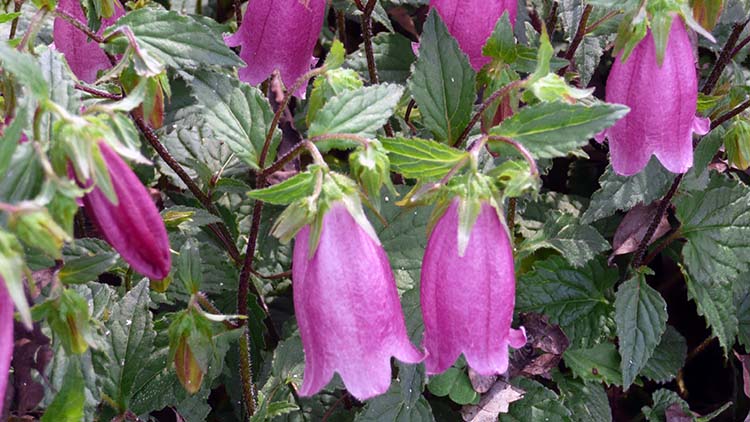
- Company
- Skagit Gardens
- Year Planted
- 2012
- Height
- 13"
- Spread
- 26"
- Number Planted
- 12
- Survival
- 100%
- Comments
-
Pendent rose-pink, bell-shaped flowers displayed above the green foliage; melts to ground in early winter (November/December); flowers from mid-May until end of October; vigorous growth—takes over an area; by mid-April it was already a green mat.
Coreopsis 'Mercury Rising'
Big Bang™ coreopsis
- Company
- Skagit Gardens
- Year Planted
- 2012
- Height
- 25"
- Spread
- 23"
- Number Planted
- 12
- Survival
- 67%
- Comments
-
Great performer; large, red colored flowers with a little yellow eye that don't fade in the sun and the heat; vigorous grower but compact; it forms an attractive, well-branched mound; flowers continuously; flowers from end of May until the middle of October; plants are evergreen.
Primula polyanthus
SuperNova primula mix primrose
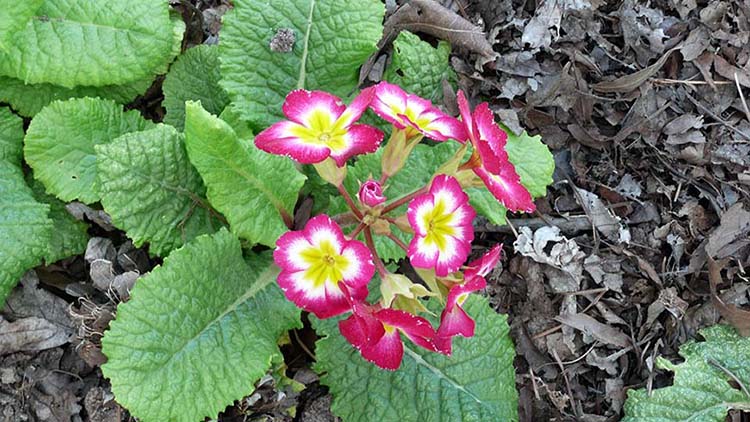
- Company
- Sakata
- Year Planted
- 2012
- Height
- 3"
- Spread
- 8"
- Number Planted
- 27
- Survival
- 0%
- Comments
-
Died fall 2013—did not tolerate our wet and cloudy winter conditions.
Perennials Planted in 2013
Digitalis purpurea
Dalmatian Purple Improved foxglove
- Company
- Ball/Kieft Seed
- Year Planted
- 2013
- Height
- 12"
- Spread
- 10.5"
- Number Planted
- 12
- Survival
- 0%
- Comments
-
Died winter 2013. Sturdy, well-branched plants were very uniform in growth and size; foliage is a dark green color; purple bell-shaped flowers with dark purple speckles on the interior, on sturdy spikes; flowers open from bottom to top of spike; the flowers provide eye-catching, vertical color from mid-July through October; can be grown as a cut flower; attracts bees and butterflies.
We apologize for not photographing this plant while it was in flower.
Digitalis purpurea
Dalmatian White Improved foxglove
- Company
- Ball/Kieft Seed
- Year Planted
- 2013
- Height
- 12.5"
- Spread
- 11"
- Number Planted
- 12
- Survival
- 0%
- Comments
-
Died Winter 2013. Sturdy, well-branched plants were very uniform in growth and size; foliage is a dark green color; bright white bell-shaped flowers with dark purple speckles on the interior, on sturdy spikes—no staking required; flowers provide eye-catching, vertical color from the end of July through late October; can be used as a cut flower; attracts bees and butterflies.
We apologize for not photographing this plant while it was in flower.
Armeria pseudarmeria
Ballerina mix thrift
- Company
- Ball/Kieft Seed
- Year Planted
- 2013
- Height
- 3"
- Spread
- 4"
- Number Planted
- 12
- Survival
- 0%
- Comments
-
Died the first season, never established; planted in May, declining by July, 25% dead by mid-August, in September only one plant living—survived until January 2014; white was the only flower color observed in the mix; flowers are small and globe-shaped; foliage is a medium green color; mounding plant habit.
We apologize for not photographing this plant while it was in flower.
Rosa 'KORelfkolo'
Kolorscape™ Cheri rose
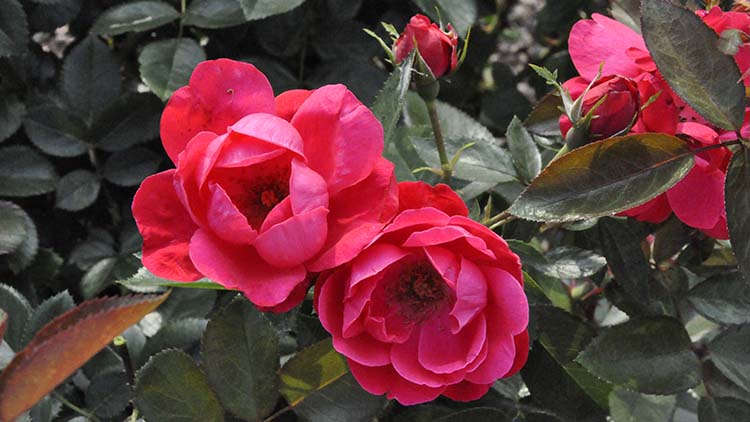
- Company
- Ball Ingenuity
- Year Planted
- 2013
- Height
- 25"
- Spread
- 28"
- Number Planted
- 5
- Survival
- 100%
- Comments
-
Dark green foliage on compact, upright plants; Forms many clusters of single, fragrant, bright pink flowers; great flower power, gives you non-stop color from early July through late November (up until first hard freeze); good resistance to black spot; can be used as a cut flower and in small scale gardens; attracts bees; low maintenance.
Rosa 'KORjuwko'
Kolorscape™ Milano rose
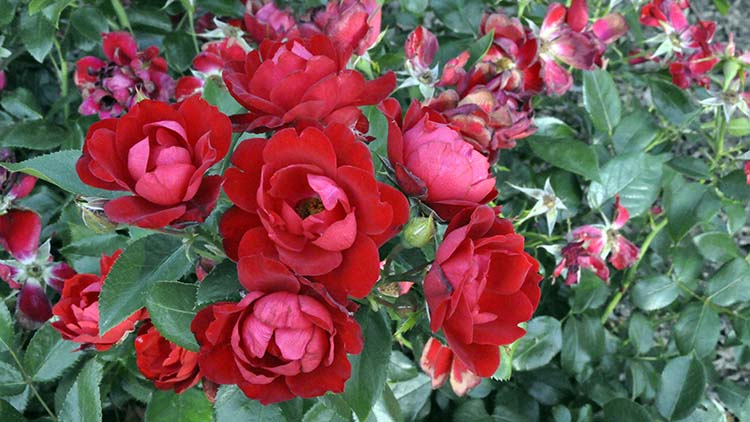
- Company
- Ball Ingenuity
- Year Planted
- 2013
- Height
- 25"
- Spread
- 19"
- Number Planted
- 5
- Survival
- 100%
- Comments
-
Dark green foliage on compact, upright plants; forms clusters of single, fragrant, bright red, flowers; great flower power, gives you non-stop color from mid-July through mid- November (up until first hard freeze); good resistance to black spot; can be used as a cut flower and in small scale gardens; attracts bees; low maintenance.
Rosaa 'KORhopiko'
Kolorscape™ Flamingo rose
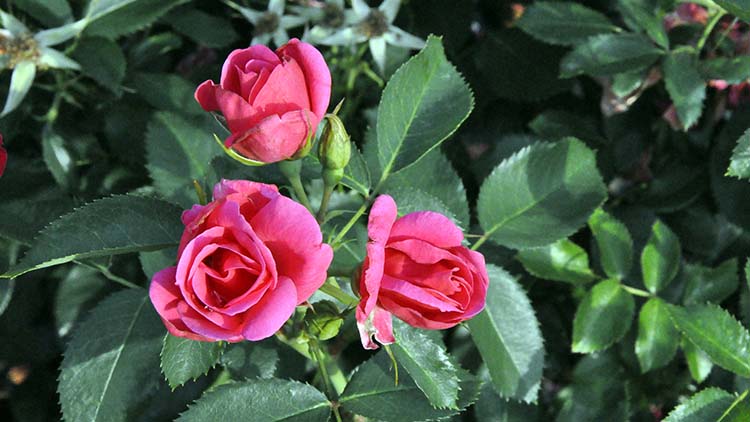
- Company
- Ball Ingenuity
- Year Planted
- 2013
- Height
- 35"
- Spread
- 15"
- Number Planted
- 5
- Survival
- 100%
- Comments
-
Large, glossy green foliage on compact, upright plants; forms clusters of single, lightly fragrant, hot pink, flowers; great flower power, gives you non-stop color from July through late-November (up until first hard freeze); good resistance to black spot; can be used as a cut flower and in small scale gardens; attracts bees; low maintenance.
Rosa 'KORsixkono'
Kolorscape™ Kardinal rose
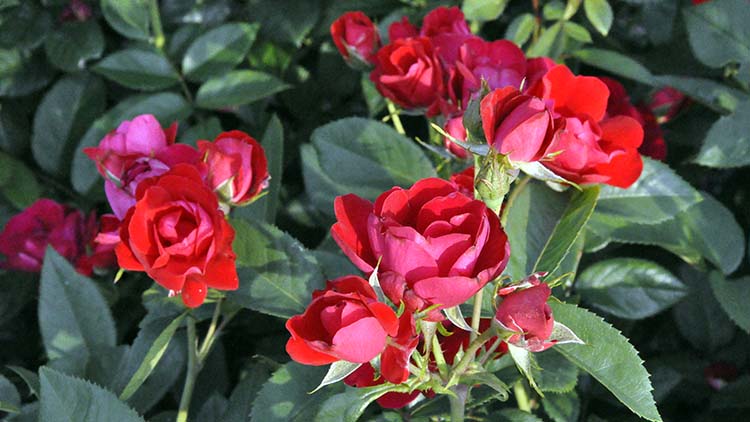
- Company
- Ball Ingenuity
- Year Planted
- 2013
- Height
- 31.5"
- Spread
- 31"
- Number Planted
- 5
- Survival
- 100%
- Comments
-
Large, glossy green foliage on compact, upright plants; forms clusters of single, lightly fragrant, clear red, flowers; great flower power, gives you non-stop color from July through late-November (up until first hard freeze); good resistance to black spot; can be used as a cut flower and in small scale gardens; attracts bees; low maintenance.

